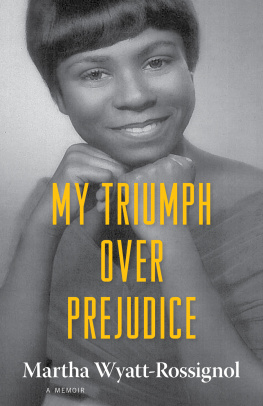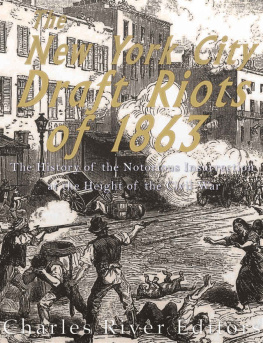Blue Monday
Standing on a Volcano: The Life and Times of David Rowland Francis
Never Been a Time
The 1917 Race Riot That Sparked
the Civil Rights Movement
HARPER BARNES

WALKER & COMPANY
NEW YORK
Copyright 2008 by Harper Barnes
All rights reserved. No part of this book may be used or reproduced in any manner whatsoever without
written permission from the publisher except in the case of brief quotations embodied in critical articles
or reviews. For information address Walker & Company, 175 Fifth Avenue, New York, NY 10010.
Published by Walker Publishing Company, Inc., New York
LIBRARY OF CONGRESS CATALOGING-IN-PUBLICATION DATA
Barnes, Harper, 1937
Never been a time : the 1917 race riot that sparked the civil rights movement / Harper
Barnes.1st U.S. ed.
p. cm.
Includes bibliographical references and index.
ISBN-13: 978-0-8027-1575-3 (hardcover)
1. East Saint Louis (Ill.)Race relationsHistory20th century. 2. East Saint Louis (Ill.)
Social conditions20th century. 3. Race riotsIllinoisEast Saint LouisHistory20th
century. 4. ViolenceIllinoisEast Saint LouisHistory20th century. 5. African
AmericansIllinoisEast Saint LouisSocial conditions20th century. 6. African
AmericansCrimes againstIllinoisEast Saint LouisHistory20th century. 7. African
AmericansCivil rightsIllinoisEast Saint LouisHistory20th century.
I. Title.
F549.E2B37 2008
977.389dc22
2008000368
First published in the U.S. by Walker Publishing Company in 2008
This e-book edition published in 2011
E-book ISBN: 978-0-8027-7974-8
Visit Walker & Companys Web site at www.walkerbooks.com
For Roseann Weiss
In memory of Julia Davis
Germany [in World War I] has nothing on East St. Louis when it comes to frightfulness. Indeed in one respect Germany does not even approximate her ill-famed sister. In all the accounts given of German atrocities, no one, we believe, has accused the Germans of taking pleasure in the sufferings of their victims. But these [white] rioters combined business and pleasure.
W. E. B. Du Bois
There has never been a time when the riot was not alive in the oral tradition.
Eugene Redmond, poet laureate of East St. Louis
Contents
[T]he East St. Louis race riot in 1917 was supposed to be about black workers replacing white workers in the packing houses. So, the white workers got mad and went on a rampage killing all them black people just shot them down like they were out shooting pigs or stray dogs. Shot them in their houses, shot babies and women. Burned down houses with people in them and hung some black men from lampposts. Anyway, black people who survived used to talk about it. When I was coming up in East St. Louis, black people I knew never forgot what sick white people had done to them back in 1917.
Miles Davis
The mob and entire white populace of East St. Louis had a Roman holiday. They feasted on the blood of the Negro.
Marcus Garvey
Race riots, as black militant H. Rap Brown famously suggested in the incendiary 1960s, are as American as cherry pie. Long before the black riots of the sixties, whites rioted against blacks in cities across the country. Decades before the Civil War, in such Northern bastions of abolition as Cincinnati, Boston, Pittsburgh, Philadelphia, and New York, and in smaller cities and towns throughout the North, blacks were attacked in the streets by gangs of whites and their neighborhoods were invaded and sacked. African Americans were severely beaten and even killed, and black homes and
In the second decade of the twentieth century alone, half a million African Americans moved from the impoverished rural South to the booming industrial cities of the North, wooed by the promise of jobs and freedom. The migration intensified in the second half of the decade in an industrial boom fueled by the First World War. Blacks arrived in Northern cities by the trainloads, and many whites responded to the African American incursion with a horrific series of racial confrontations, riots, and massacres that broke out in cities across the nation, beginning in the summer of 1917 in East St. Louis.
The East St. Louis race riot was not only the first but officially the deadliest of a series of devastating racial battles that swept through American cities in the World War I era. The death toll in East St. Louis was at least forty-eight, a figure not exceeded in the twentieth century until the 1992 Rodney King riot in Los Angeles, with fifty-five deaths. Officially, thirty-nine African American men, women, and children were killed in East St. Louis. But, as with other riots in the period, including those in Tulsa and Chicago, it is likely that the official East St. Louis figures on the deaths of black men, women, and children, many of them undocumented, are too low. Historians, journalists, and civil rights leaders who have studied the East St. Louis riot believe that more than one hundred African Americans, and perhaps as many as two hundred, were killed in the impoverished industrial city on the east bank of the Mississippi, with many of their bodies, including those of small children and infants, burned beyond human recognition in gasoline-ignited shacks or dumped in the deep, fast-flowing waters of Americas largest river and its sewage-ridden tributaries. What happened in East St. Louis in the summer of 1917, wrote Gunnar Myrdal in American Dilemma, his landmark study of race in this country, was not so much a riot as a terrorization or massacre, a mass lynching.
East St. Louis, Illinois, an industrial and meatpacking town of about seventy-five thousand people, about twelve thousand of them black, lay
Although there is little evidence of the reign of crime blacks were accused of, there were a few particularly lurid crimes with racial overtones, at least as they were presented in the local press, and whites generally blamed blacks for the increasing dangers of walking the streets. Perhaps more importantly, blacks were competing with whites for jobs, encouraged by the powerful white industrialists who controlled the city from behind the scenes, polluting its air and streams while paying very low taxes. Employers used non-union strikebreakers, some of them black, to force white unions into disarray and collapse, and continued to lure blacks North with promises of jobs long past the time when the job market was saturated.
Blacks were blamed for the citys troubles, and were attacked by white mobs in the street throughout the spring and early summer of 1917, leading up to a full-scale riot on July 2. By the end of the long, sweltering midsummer day, hundreds of blacks had been brutally attacked, thousands fled the city, and more than three hundred homes and places of business had been destroyed by fire. At military and congressional hearings in the aftermath of the riot, dozens of eyewitnesses, black and white, described their experiences in sometimes very painful detail, and many of these descriptions are quoted here for the first time.
In an atmosphere of racial and economic fear, whites and blacks had been pitted against one another by the purposeful acts of wealthy and powerful whites. It was the work not just of industrialists but of politicians as well, ranging from the Democratic mayor of East St. Louis to the president of the United States, Woodrow Wilson, who used a Southern Strategy in his bitterly fought reelection campaign in the fall of 1916 that increased the division between black and white in the region that included East St. Louis. In the riots immediate aftermath, the tragedy was investigated by, among others, NAACP founder W. E. B. Du Bois and pioneering black feminist and anti-lynch-mob activist Ida Wells-Barnett, both of whom interviewed survivors and wrote of the terror visited upon the twelve thousand black citizens of East St. Louis. Their accounts, which are also part of this book, became rallying points for the growth of the NAACP, the Urban League, and other black organizations, including Marcus Garveys back-to-Africa United Negro Improvement Association.
Next page




